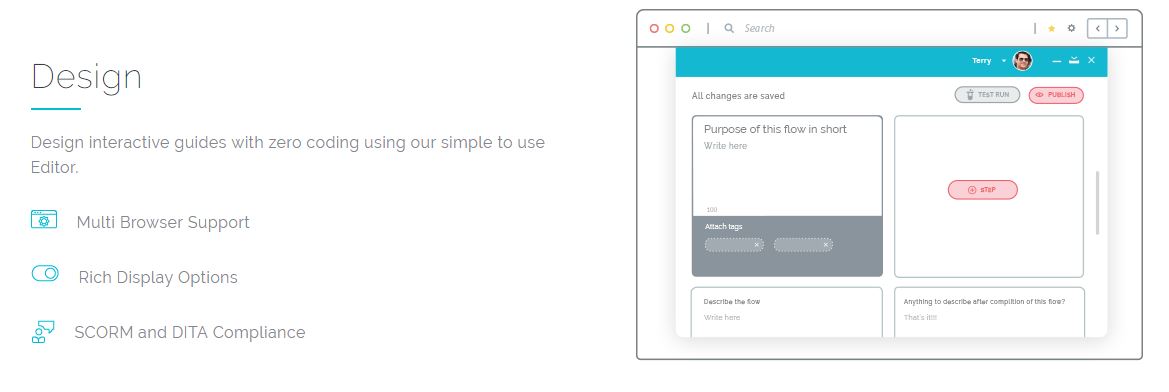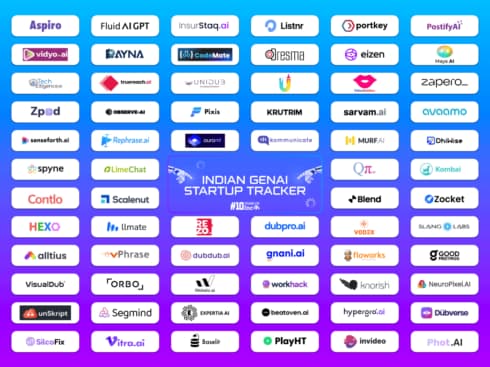Integrating a new process in an enterprise workforce of 1000s is usually a time-intensive job. It requires understanding the process, explaining it and then ensuring that the process is followed to the letter. Traditionally, these how-to tutorials have been conducted manually, with a human touch point providing information and instruction. While having a human touch point at the helm is a sound idea, it could become a strain on manpower, labour and resources, ultimately leading to a loss in efficiency. This could be because the workforce is learning to operate on the new workflow.
B2B performance support platform Whatfix is looking to change the way this workflow is handled in large (enterprise) and mid-scale companies.
Started by Khadim Batti and Vara Kumar in 2013, India and US-based Whatfix is a SaaS solution for organisations looking to introduce training instructions via interactive guides for a seamless on boarding process in all enterprise areas such as HR, CRM, ERP, Accounting and more. It has raised a significant amount of funding from marquee names such as Helion Venture Partners, Stellaris Venture Partners – a seed round in 2014 from Helion and a Series A round from Helion and Stellaris more recently in April 2017. Angel investors such as Gokul Rajaram, Girish Mathrubootham, Aneesh Reddy, and Vispi Daver also backed the startup.
“User onboarding, training and support are challenges faced by pretty much all the enterprises, who combined spend $500Bn+ on software every year. Whatfix’s product is a quantum leap improvement to the current approach of user help through static articles and manuals,” stated Alok Goyal, Partner at Stellaris Venture Partners while commenting on the funding.
The Whatfix journey began three years ago – when Khadim and Vara worked together at Huawei, building up business solutions in India, an ‘intrapreneurial position,’ as Khadim remembers which led them to believe that they could actually start something together.
Whatfix V.1: From A Marketing Search Enabler For SMBs To A Community Of Tutorials
“We started off in a small office, some 200 by 300 sq.ft,” begins co-founder Khadim with a nostalgic chuckle. “Our initial idea was to figure out marketing for SMBs, a vast market. So we created a SearchEnabler that would turn into a marketing DIY (do-it-yourself) process for SMBs.”
When prompted, he elaborates by saying that the SearchEnabler basically crawled across the interwebs for data points, crunched it and identified recommendations in terms of marketing, especially in social media, which was just about taking off in the early 2010s.
Over one year, they had bagged about 100 customers with a small ticket size (undisclosed).
But, all the customers who were on the DIY platform expected one thing – support. Handholding customers when they needed instruction and or information was key.
This, according to Khadim, was the very genesis of Whatfix as it is today.

Between 2011 and 2013, the company focussed on creating validation by providing solutions for everyone. “We built an open community that crowdsourced all the information needed to create these ‘flows’- a term we used for workflows that were interactive and useful. These flows were in the form of how-tos and tutorials, something SMBs wanted a solution for.”
Khadim informs me that contributions began pouring and they were up by approximately 2,000 contributions indicating a healthy, helpful online community but as with any fledgeling business monetisation was a huge problem.
“It took us three days to sit down, brainstorm and decide to shut down the original SearchEnabler,” he admits. The reason for making this tough call – creating a painkiller solution (pull product) that could be monetised from day one.
Helion Ventures Bet On Just 2 People When They Funded Us
When the duo decided to totally change direction and take Whatfix in a new direction, they were very clear on what they were solving for – build what is required for the market, instead of the other way round, validate the solution with a dynamic pricing page. “We wanted to get it right the first time with the new platform. All our efforts were geared towards this.”
To this end, they cold-emailed SMEs, announced on the Whatfix-created community to list the evolved features. The solution was completely private, with ample opportunities to customise and integrate with a client’s website and platform.
“We got two paid customers, initially. A hospital management system in the US and a library in France,” Khadim recalls. The idea was to keep engaging the customers on the community as well as on the web for the first 30 days till the product acquired some polish before formally rolling it out.
Whatfix also joined Rajesh Sawhney’s GSF Accelerator in 2014 and ended up going to the US for some much-needed Valley experience. “When we launched the platform, our core focus was on figuring out the right kind of price point. After talking to the Valley experts, we realised it should be on the higher side for the service we were providing.” Joining GSF proved fortuitous for the company as they were nominated for a global startup Hanhwa competition held in Seoul, South Korea and ended up winning $300K as prize money.
But it was Helion Ventures that also bet on the company, pouring in about INR 5.5. Cr ($851K) in the company in early 2015. As the team still consisted of Khadim and Vara it behooved me to ask them about the kind of pitch they used to impress their key investor. The pitch, incidentally, also involves the core philosophy that Whatfix operates on, currently.
“65% of people on the Internet want to solve their own problems, they prefer self-service over being told what to do. We simply made it easier to enable this kind of help and instruction in the form of videos and texts in a data-intensive world. Performance support is a multibillion dollar industry with very little innovation happening so far, we just leveraged this fact to our advantage.”
The Whatfix Experience
The Whatfix solution has now been configured such that it can be used in any way inside a client’s app or website. It uses proactively engaging communication for new users and regular users, utilising business intelligence in order to tailor this communication to their specific needs. It also uses reactive communication, wherein it sits in the background of a company’s process and only provides step-by-step help for any problem encountered by the user inside the app itself.
The SaaS experience begins with an in-app Editor that comes with a no-fuss design to placehold the interactive workflow for complicated processes such as ERP, CRM, ITSM among others. As each of these processes require a different kind of approach and understanding, Whatfix uses multilingual support and smart targeting (figuring out which user is using which workflow, for instance) to only engage on that particular point.
Lastly, as all processes can only become more efficient through constant and dynamic analysis, Whatfix provides user-level tracking, customised reports (which can be fixed at the design stage itself) as well as API support for integrating external analytics. “The intention is to solve whatever problems the user faces inside the app itself to increase efficiency.”

Numbers And Figures
Whatfix began out of a small office in Bengaluru and now boasts of 43 people, split between India and the US. As with most SaaS businesses, the company heavily relies on inbound marketing and inward sales for generating leads and closing clients. “It began as an experiment,” admits Khadim. “After the initial cold emailing, we pivoted our marketing strategy too, so that our customers could find us, get on the website and start using Whatfix.”
As per Khadim, Whatfix’s clients consist of such marquee names as NASA, Flipkart, AAA, Booking.com (part of The Priceline Group), among others. Further breaking this down, they have 15 Fortune 500 companies and 25 Fortune 1000 companies. 90% of their client base is outside of India, with 60% comprising the US and 30% the rest of the world. Whatfix currently boasts of around 200 clients in 20 countries across the world including the US, India.
Of course, the deployment of inward sales and its robust customer base leads to asking the next obvious question – how difficult is it selling SaaS globally from India?
“The challenges when we are a small company selling to global clients from India include the time-difference,” admits Khadim, with a chuckle. He also adds that, with a lean startup team, resources need to be routed efficiently as well as putting the proper infrastructure in place to take care of the above two issues. “Playing in a defined category such as ERP SaaS, people automatically look for the top 2-3 players to fulfil their needs. But with an undefined category, a nascent category, it is easy to gain the trust and confidence of people to have them give your product a try.”
Unlike serving to customers in India, which requires a different kind of thinking (economical, affordable services), for global customers such as Fortune 500 companies and the larger banks, the Whatfix team figured out that timing was crucial. So they set up a pipeline for the first six months and gritted it out.
The result: now, they close one or two marquee clients (Fortune 1000) per month. Although the Whatfix team categorically refuse to disclose approximate revenues, they do claim 8x growth in the last 12 months.
Building Partnerships With Competitors
Whatfix currently also works with software such as Oracle Now, Sharepoint, Service Now, Salesforce, companies that could also be considered competitors. Workday as well as homegrown analytics companies that provide intuitive and interactive customer support. But, as per Khadim, the main differentiator is that Whatfix can fit in anywhere handholding is required as it is horizontal in nature. As Khadim defends, “We actually complement our competitors such as Salesforce, Zoho. We have incorporated licenses for customised employee needs that work on other systems and basically simplify the customer experience.”
But, conversely, with all this ease of process, Khadim admits that it is harder for them to sell the product in India than it is abroad. “There is not that much appreciation of innovation in India, as it is in the US. Plus, enterprises here prefer dealing with second-generation companies.” To combat this barrier-to-entry in India and also around the world, Whatfix came up with a new solve – partnerships.
Large enterprises use third-party implementers when onboarding a new process, these implementers are specialists in deploying certain processes pertaining to CRM, or HR, sales etc. The idea is to bundle the Whatfix platform with the process so that the support part is already taken care off, in-app.
Currently, Whatfix is providing this kind of training programme support in the US, Europe and South Africa. According to Khadim, they are ideally situated – sitting in India and the US, the hotbed of consulting companies all over the world and looking to crack that market. Their short-term future goal includes amassing triple the number of existing clients in the next 12 months while continuing to hit the sweet spot on PMF (product-market fit).
Advice To Budding SaaS Entrepreneurs
As a fitting conclusion, Khadim imparts a few learnings for young guns looking to become the next-gen SaaS entrepreneurs. Selling to enterprises requires altering architecture and pipeline to take the different levels of security clearances into account, and to make the product compliant to individual customer needs. “As soon as you gain the first few clients, ramp up the product and go global immediately. Don’t wait for the perfect product,” he adds.
Telling a story matters. “References, word of mouth involve around convincing the client of the viability of your product. Which is why it is important to have a good story to go with your pitch. It helps in closing the deal.”
And lastly, Khadim cautions against being a spendthrift while you build your business. “Be frugal. Funding will come when you are solving the right problem in the right market. But it can’t be the other way round,” he ends.
For a company that began with a team of two and an idea that won a prize, the advice and the future seem sound.
[This article is part of Inc42’s SaaS series where we will be covering different aspects of SaaS in India and abroad.]


































 Ad-lite browsing experience
Ad-lite browsing experience